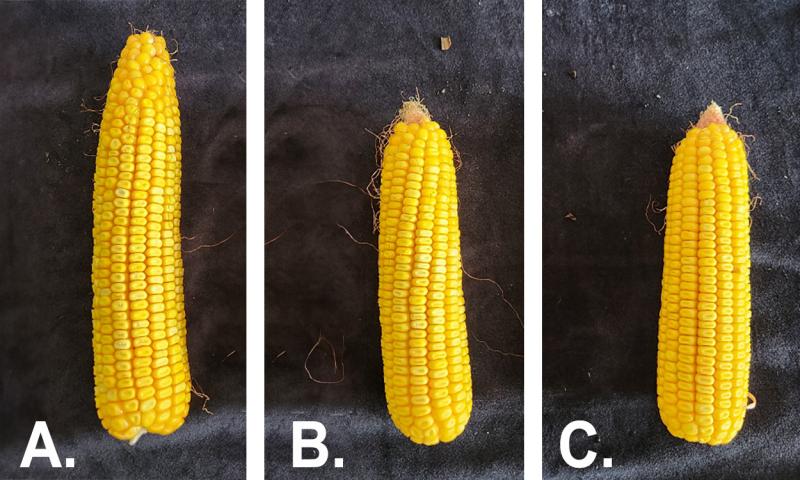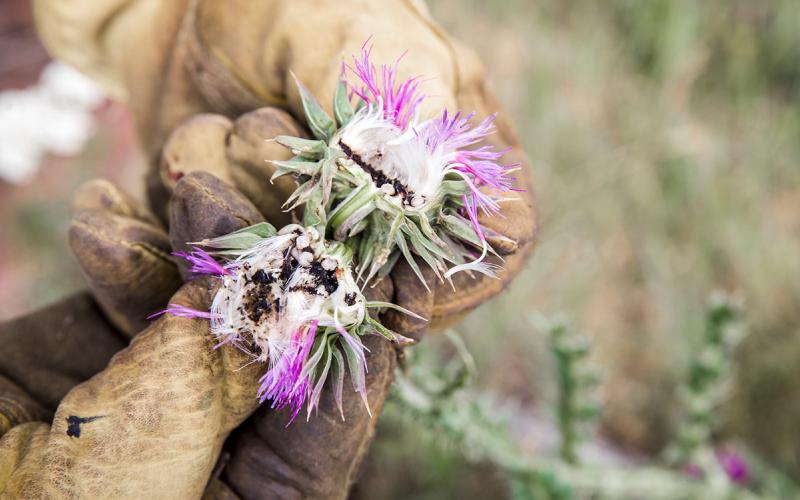Written collaboratively by Eric Jones, Philip Rozeboom, Jill Alms, and David Vos.
An article was written earlier this growing season about using 2,4-D and dicamba for weed management in corn. Injury was observed in three locations where 2,4-D and dicamba were applied to V5 corn, but the injury could not be correlated to yield loss. The auxin herbicide-treated corn has been grown out of the injury and has produced ears now (September 17, 2024).
Herbicide Impacts on Corn Ears

While doing some final weed control ratings, ears were pulled from corn plants in plots treated with 2,4-D, dicamba, or a standard corn herbicide program that relies on Group 27 herbicides (such as mesotrione [Callisto], isoxaflutole [Balance], topramezone [Impact/Armezone]) pre- and postemergence.
The ears that were treated with the standard corn herbicide programs appeared large, and kernels were present to the ear tip (Figure 1-A), while the 2,4-D (Figure 1-B) and dicamba (Figure 1-C) treated ears appeared smaller in size and had some ear tip back (kernels not produced to the end of the ear tip). While these handpicked ears do not tell the whole story of the corn yield in these plots, the implications still suggest that using 2,4-D and dicamba in corn should be done with caution.
Application Considerations
The rates of 2,4-D and dicamba used in these trials were applied at the maximum labeled rate (1 pint per acre) and corn height (V5), which increases the likelihood of injury. These herbicides should be applied to corn early postemergence (V2 to V3) to minimize injury. Additionally, if applying at the early postemergence timing, the rate applied can be reduced (1/2 pint to 1 pint is labeled) to minimize crop injury but still be effective on small broadleaf weeds. Applying safened dicamba (for example, Diflexx or Status) can also minimize the potential of crop injury when applying to corn past V5. Keep in mind that the rates for Status (2.5 fluid ounces to 10 fluid ounces per acre) differ from non-safened dicamba (1/2 pint to 1 pint per acre). Safened dicamba can be applied to corn up to V7 (Diflexx) and V8 (Status), but weeds should be small (4 inches or less). While there is no safened 2,4-D; 2,4-D-tolerant corn can be planted to increase crop safety (for example, Enlist corn). Keep in mind that Enlist herbicide (2,4-D choline) can only be applied to Enlist corn and the rates (1.5 pints to 2 pints per acre) differ compared to 2,4-D amine/ester (1/2 pint to 1 pint per acre). Enlist can also be applied to corn up to V8, but weeds should be small in size (4 inches or less).
Key Takeaways
Again, 2,4-D and dicamba are likely not going to replace Group 27 herbicides, but these herbicides can still have a place in corn weed management. The same messages from the earlier article still apply, but use this article as a reminder to use all the tools in the toolbox to manage weeds, but remember that using a tool incorrectly can do more harm than good. For example, you wouldn’t use a 10-pound sledgehammer for joinery on fine furniture just, as you wouldn’t use a finishing hammer to drive in a fence post. Using the products correctly will minimize crop injury (and potential yield loss) while still effectively managing weeds. Consult the latest South Dakota Pest Management Guide for Corn for an extensive herbicide list.


